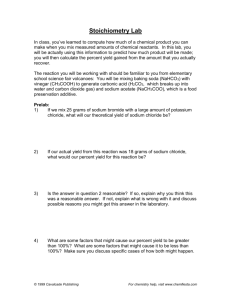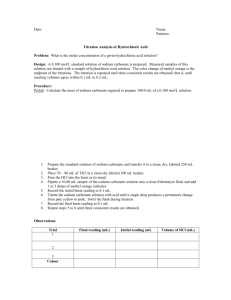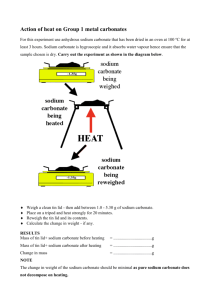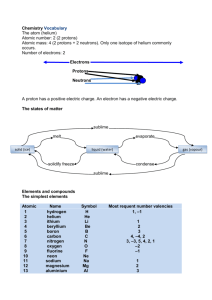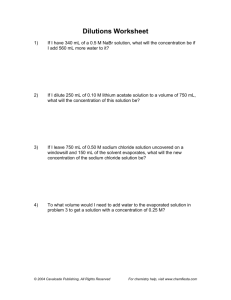Stoichiometry Lab - Nicolet High School
advertisement
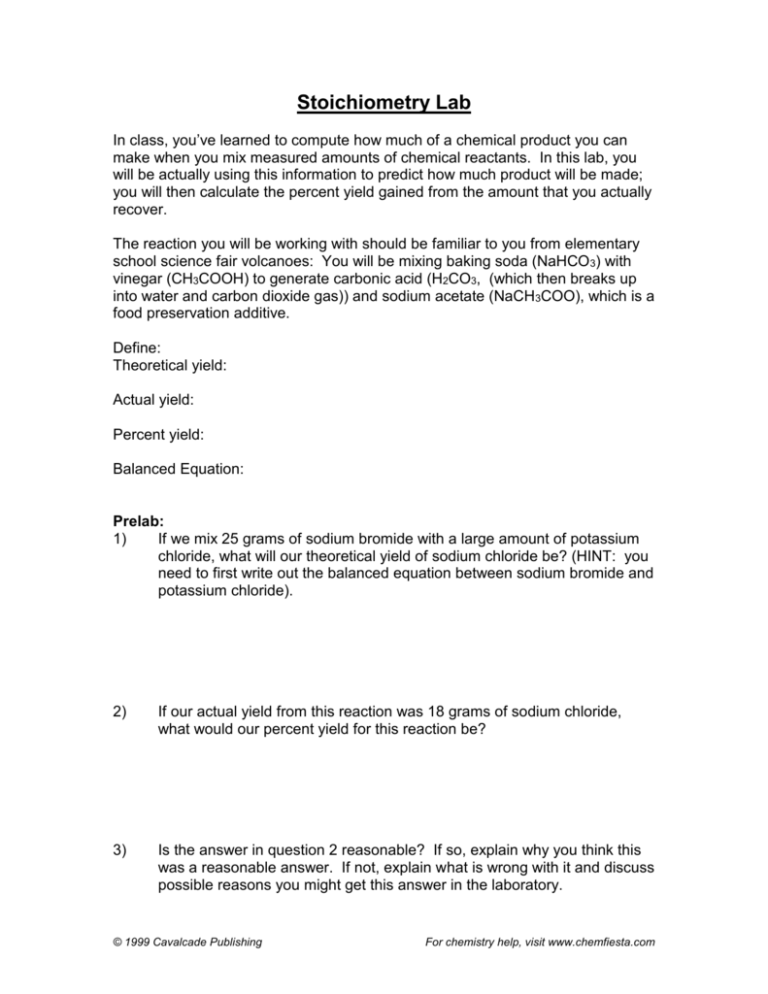
Stoichiometry Lab In class, you’ve learned to compute how much of a chemical product you can make when you mix measured amounts of chemical reactants. In this lab, you will be actually using this information to predict how much product will be made; you will then calculate the percent yield gained from the amount that you actually recover. The reaction you will be working with should be familiar to you from elementary school science fair volcanoes: You will be mixing baking soda (NaHCO 3) with vinegar (CH3COOH) to generate carbonic acid (H2CO3, (which then breaks up into water and carbon dioxide gas)) and sodium acetate (NaCH3COO), which is a food preservation additive. Define: Theoretical yield: Actual yield: Percent yield: Balanced Equation: Prelab: 1) If we mix 25 grams of sodium bromide with a large amount of potassium chloride, what will our theoretical yield of sodium chloride be? (HINT: you need to first write out the balanced equation between sodium bromide and potassium chloride). 2) If our actual yield from this reaction was 18 grams of sodium chloride, what would our percent yield for this reaction be? 3) Is the answer in question 2 reasonable? If so, explain why you think this was a reasonable answer. If not, explain what is wrong with it and discuss possible reasons you might get this answer in the laboratory. © 1999 Cavalcade Publishing For chemistry help, visit www.chemfiesta.com 4) What are some factors that might cause our percent yield to be greater than 100%? What are some factors that might cause it to be less than 100%? Make sure you discuss specific cases of how both might happen. © 1999 Cavalcade Publishing For chemistry help, visit www.chemfiesta.com Section 1: Computing the amounts of reactants that we need In this lab, you will need to do a reaction where baking soda will react with an excess of vinegar. By doing this, you will (hopefully!) ensure that you will get 100% actual yield for the reaction. For our reaction, we will need to use 0.05 moles of baking soda, which we will call by its chemical name, sodium hydrogen carbonate, for the rest of this lab. If we use much more than 0.05 moles of baking soda, the reaction will be too large and we will risk having some of the reaction products pour over the side of the flask when we mix it with the vinegar (which we will call acetic acid). In the space below, calculate how much sodium hydrogen carbonate we will need for this lab: For this lab, we will use _________ grams of sodium hydrogen carbonate. Section 2: The reaction In this section of the lab, we will be doing the reaction discussed in the prelab. 1) Measure out the weight of sodium hydrogen carbonate that you calculated you would need in the first section of this lab. Make sure that the amount you use is as close as you can make it to this amount. Write the exact amount of sodium hydrogen carbonate that you used here: Amount of sodium hydrogen carbonate used: ______________ 2) Dissolve the sodium hydrogen carbonate in about thirty milliliters of water. Stir the solution until most or all of it is dissolved (if a little won’t dissolve, that’s OK). 3) Weigh a clean 250 mL flask. You will need the weight of the empty flask at the end of the lab. Weight of the empty 250 mL flask: ______________ 4) Add the sodium hydrogen carbonate solution to the preweighed 250 mL flask. © 1999 Cavalcade Publishing For chemistry help, visit www.chemfiesta.com 5) Obtain 150 mL of acetic acid (a.k.a. vinegar) and slowly add it to the sodium hydrogen carbonate solution. You will observe the formation of bubbles when the acetic acid is added to the sodium hydrogen carbonate solution. Wait until the bubbling subsides before adding more acetic acid. When all of the acetic acid has been added, stir for two minutes before moving on to step 6. 6) Place the flask in a drying oven overnight. 7) Remove the flask from the drying oven the next day. The powder that you observe inside is the product of the reaction, sodium acetate. Measure and record its weight. Weight of the flask, after the reaction: _______________ 8) When this is done, you can rinse out the flask and any other glassware you used. All waste can go down the sink. Questions: 1) Using the exact weight of sodium hydrogen carbonate that you measured in step 1 and the equation that you wrote in the problem above, what is the theoretical yield of this reaction? 2) Calculate the actual yield of sodium acetate that you recovered in this lab, using the weight of the empty flask and the weight of the flask after the reaction. 3) Using the actual yield of sodium acetate that you measured in step 3 and the theoretical yield of sodium acetate that you calculated in step 2, calculate the percent yield of sodium acetate recovered in this lab: © 1999 Cavalcade Publishing For chemistry help, visit www.chemfiesta.com 4) Was your percent yield of sodium acetate 100%? What factors do you think caused any error that you found? Explain, using specific examples and do not cite “human error”. 5) Do you think it is common for chemists to get 100% yields for chemical reactions? Why or why not? 6) If you had to do this lab again, what would you do differently to improve your answers? Explain, using specific examples: © 1999 Cavalcade Publishing For chemistry help, visit www.chemfiesta.com
